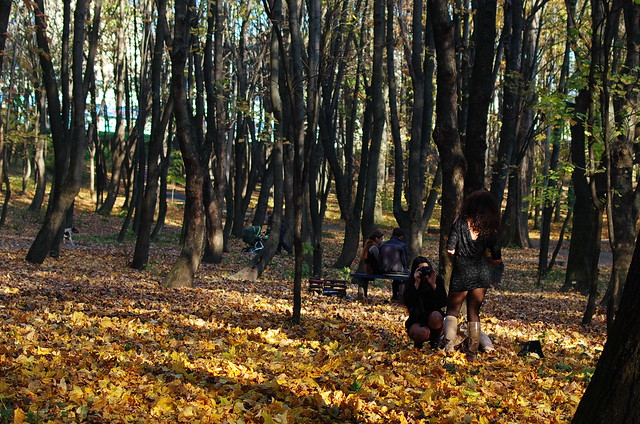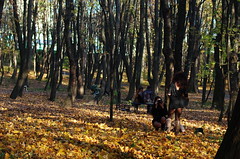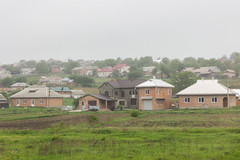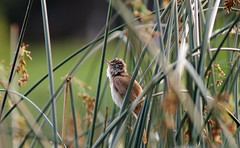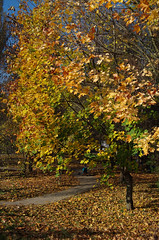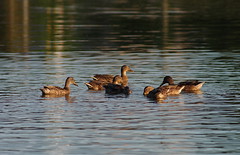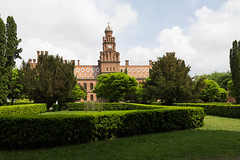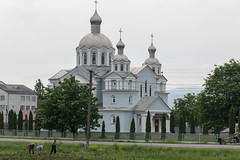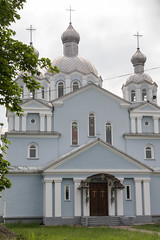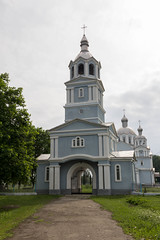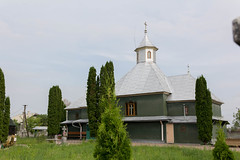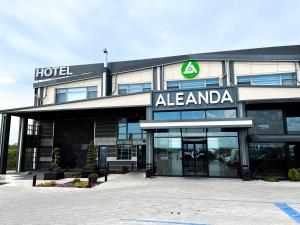Chernivtsi
Chernivtsi (Ukrainian: Чернівці́, Ukrainian: [tʃern⁽ʲ⁾iu̯ˈts⁽ʲ⁾i]; Romanian: Cernăuți,Romanian: [tʃernəˈutsʲ]; see also other names) is a city in southwestern Ukraine, situated on the upper course of the Prut river. Formerly the capital of the historic region of Bukovina, which is now divided between Romania and Ukraine, Chernivtsi serves as the administrative center for the Chernivtsi raion, the Chernivtsi urban hromada, and the oblast itself. In 2022, the Chernivtsi population, by estimate, is and the latest census in 2001 was 240,600.
The first document that refers to this city dates back to 1408, when Chernivtsi was a town in the region of Moldavia, formerly as a defensive fortification, and became the center of Bukovina in 1488. In 1538, Chernivtsi was under the control of the Principality of Moldavia under Ottoman Empire suzerainty, and the Moldavian control lasted for two centuries until 1774, when Austria took control of Bukovina in the aftermath of the Russo-Turkish War. Chernivtsi (known at that time as) became the center of the Galicia's Bukovina District until 1848, later becoming the Duchy of Bukovina until 1918. In the aftermath of World War I, Romania united with Bukovina in 1918, which led to the city's being renamed to , which lasted until the Soviets occupied Bessarabia and Northern Bukovina. Chernivtsi was under the control of the Soviet Union from 1940 to 1941, after which Romania recovered the city, and then again from 1944 until its dissolution, after which it became part of independent Ukraine.
Chernivtsi is viewed as one of Western Ukraine's main cultural centers. The city is also considered one of Ukraine's important educational and architectural sites. Historically a cosmopolitan community, Chernivtsi was once dubbed "Little Vienna" and "Jerusalem upon the Prut". Chernivtsi is twinned with seven other cities around the world. The city is a major regional rail and road transportation hub, also housing an international airport.
Names
Aside from its Ukrainian name of Chernivtsi, the city is also known by several different names in various languages, which still are used by the respective population groups much as they used to be throughout the city's history, either in connection with the rule by one country or another or independently from it: Romanian: Cernăuți (Romanian: [tʃernəˈutsʲ]); German: Czernowitz (German: [ˈtʃɛɐ̯novɪts]); Polish: Czerniowce; Hungarian: Csernovic, Yiddish: טשערנאָוויץ, Russian: Черновцы́, (In Russian: Чернови́цы). In the times of Halych-Volyn Principality the city's name was Chern.
In "Documents of Western Russia" (Russian: Акты Западной России) published in Saint Petersburg in 1846 (Volume 1, page 32, document #21), the city is mentioned as Chernov'tsi (Russian: Черновьци).
History
Prehistory
Archaeological evidence discovered in the area surrounding Chernivtsi indicates that a population inhabited it since the Neolithic era. Later settlements included those of the Cucuteni-Trypillian culture, the Corded Ware culture; artifacts from the Bronze and Iron Ages were also found in the city. In the Middle Ages there lived East Slavic tribes White Croats and Tivertsi.
Under Principality of Halych
A fortified settlement located on the left (north-eastern) shore of the Prut dates back to the time of the Principality of Halych and is thought to have been built by Grand Prince Yaroslav Osmomysl. Legendary accounts refer to this fortress-city as Chern, or Black city; it is said to owe its name to the black color of the city walls, built from dark oak layered with local black-colored soil. This early stronghold was destroyed during the Mongol invasion of Europe by Boroldai in 1259. However, the remaining ramparts of the fortress were still used for defense purposes; in the 17th century they were augmented with several bastions, one of which is still extant.
Following the destruction of the fortress, later settlements in the area centered on the right (south-western) shore of the Prut River, at a more strategically advantageous, elevated location. In 1325, when the Kingdom of Poland seized control of Galicia, and came into contact with the early Vlach (Romanian) feudal formations, a fort was mentioned under the name
Țețina; it was defending the ford and crossing point on the Prut River. It was part of a group of three fortifications; the other two being the fortress of Hotin on the Dniester to the east, and a fort on the Kolachin River, an upriver tributary of Prut.
Under Principality of Moldavia
Between 1359 and 1775, the city and its surroundings were part of the Principality of Moldavia, one of the historic provinces of Romania; the city being the administrative center of the homonymous ''ținut'' (county). The name Cernăuți/Chernivtsi is first attested in a document by Alexandru cel Bun (Alexander the Good) on 8 October 1408. In Ottoman sources, the city was mentioned as "Çernovi", a phonetic transliteration of a Latin cognomen meaning
new castle (see French Castelnau or Welsh Carno).
Under Austro-Hungarian rule
In 1775, the northwestern part of the territory of Moldavia was annexed by the Habsburg Empire; this region became known as Bukovina. The city became the region's capital, organized as the Bukovina District part of the Kingdom of Galicia and Lodomeria, which in 1849 was raised in status and became known as the Duchy of Bukovina, a crownland of the Austrian Empire. The city received Magdeburg rights. The city began to flourish in 1778 when Knight Karl von Enzenberg was appointed the chief of the Military Administration. He invited many merchants, craftsmen and entrepreneurs to help develop trade and other businesses. Saint Peter's Fairs (1–15 July) had given a new vibrant impulse to the market development from 1786. In the late 19th century the German language—due to the Habsburg and the very important Jewish influence—became the lingua franca and more and more newspapers were edited in German, also a remarkable literary production in German began in this period, featuring most prominently Karl Emil Franzos.
During the 19th and early 20th century, Chernivtsi became a center of both Romanian and Ukrainian national movements. In 1908, it was the site of the first Yiddish language conference, the Czernowitz Conference, coordinated by Nathan Birnbaum. When Austria-Hungary dissolved in 1918, followed by two years of political uncertainty in Europe due to the aftermath of World War I, the city and its surrounding area became part of the Kingdom of Romania, which gained worldwide diplomatic recognition by the end of 1920. During those two years, even most city residents did not know of which country they were citizens, with most assuming Czernowitz still belonged to Austria-Hungary. German remained the lingua franca of the city and its suburbs for another decade. In 1930, the city reached a population of 112,400: 26.8% Jews, 23.2% Romanians, 20.8% Germans, 18.6% Ukrainians, the remainder Poles and others. It was one of the five university centers of interwar Romania.
Soviet occupation and rule
In 1940, the Red Army occupied the area; the area around the city became known as Chernivtsi Oblast, and was allotted to the Ukrainian SSR by the Soviet Union. The city's large Romanian intelligentsia found refuge in Romania; while the Bukovina Germans were "repatriated" according to a Soviet-Nazi agreement. Under the regime of military dictator Ion Antonescu, Romania had switched from an ally of France and Britain to one of Nazi Germany; subsequently, in July 1941, the Romanian Army retook the city as part of the Axis attack on the Soviet Union during World War II. Chernivtsi would become the capital of the Romanian Bukovina Governorate. In August 1941, Antonescu ordered the creation of a ghetto in the lowland part of the city, where 50,000 Bukovina Jews were crammed, two-thirds of whom would be deported in October 1941 and early 1942 to Transnistria, where the majority died. The Romanian mayor of the city Traian Popovici managed to persuade Antonescu to raise the number of Jews exempted from deportation from 200 to 20,000. In 1944, when Axis forces were driven out by the Red Army, the city was reincorporated into the Ukrainian SSR. Over the following years, most of the Jews emigrated to Israel; the city was an important node in the Berihah network. Bukovina Poles were expelled by the Soviets after World War II. The city became a predominantly Ukrainian one.
Independence
Since 1991, Chernivtsi has been a part of an independent Ukraine. In May 1999, Romania opened a consulate general in the city.
Until 18 July 2020, Chernivtsi was designated as a city of oblast significance and did not belong to any raion. As part of the administrative reform of Ukraine, which reduced the number of raions of Chernivtsi Oblast to three, the city was merged into Chernivtsi Raion.
2022 Russian invasion of Ukraine
Since the start of the invasion, the city has been a host for refugees from the fighting in eastern and central Ukraine and a resting point for refugees on their way to nearby Romania. Some Chernivsti residents have also left the country.
Symbolics
Coat of arms
The Chernivtsi coat of arms is framed by a bronze ornamental cartouche, and a red heraldic shield depicting an open stone gate with a figured trident in the middle. Under the gate, there are two crossed laurel branches, tied with ribbons. The crown of the symbol is the stone crown.
Flag of Chernivtsi
The Chernivtsi flag consists of a tree, the top, and a rectangular cloth, the front of which forms framed by a red tooth-like ornament white background with an inscription in Ukrainian in the center, over which there is inscribed in Ukrainian: "Chernivtsi". Under the coat of arms, there is the sign "1408" – the date of the first written mention of the city. On both sides of the coat of arms and all four corners of the field are filled with floral ornaments and with the addition of two beech branches with nuts and leaves. The reverse side is formed by a yellow b…
Hotels Chernivtsi
Looking for places related to Chernivtsi?
Those are other destinations to find places related to Chernivtsi:
